57 Bugs That Diatomaceous Earth Kills or Keeps Away
When I first started gardening, I was incredibly excited, especially when my tomato and pepper plants started taking off. But it didn’t take long for me to realize that gardening wasn’t just about nurturing plants—it also meant contending with bugs that wouldn’t hesitate to destroy all my hard work.
I wanted to avoid chemical pesticides, so I started looking around for a natural, non-toxic pest management method, and that’s when I discovered diatomaceous earth (DE).
But what garden pests will diatomaceous earth kill or keep away?
Diatomaceous earth is an effective pesticide against a variety of destructive bugs, particularly soft-bodied insects, beetles, caterpillars, and moths. DE’s microscopic, sharp-edged particles pierce bugs’ protective coatings and absorb their moisture, causing dehydration and premature death.
In this article, I’ll provide a list of 50+ bugs that DE works well against (plus a few that aren’t as susceptible) before covering the following important topics:
- Understanding what diatomaceous earth is and how it hinders or kills off insects.
- Identifying why certain bugs can be controlled using diatomaceous earth, with a specific focus on soft-bodied insects, beetles, and caterpillars.
- Explaining how to use diatomaceous earth in your garden, including safety measures and potential drawbacks.
If you’re dealing with a specific pest, check out my list below to see if it’s one of the bug types listed there.
Also, if you’ve never used DE before, here’s what you’ll need to get started. I’ve used these products in my own backyard, and I can vouch for how well they work:
Now that I’ve covered a few basics, let’s take a closer look at the bugs diatomaceous earth kills and why DE is a great option for controlling pests in your garden.
What Bugs Will Diatomaceous Earth Kill, Harm, or Hinder?
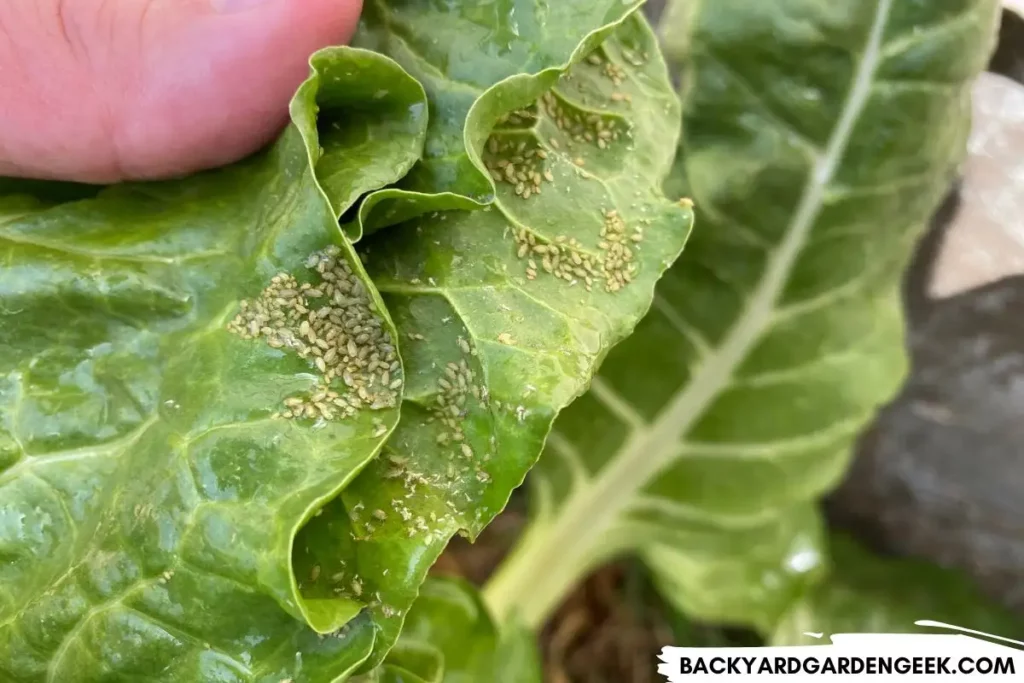
Before I cover the details of what diatomaceous earth is and why DE is so effective when it comes to pest control, here’s a list of bugs that DE will kill or keep away:
- Ants: These little insects are usually harmless, but they’ll protect aphids if given the chance, and fire ants or leafcutter ants can sting or cause damage to plants.
- Aphids: These small, soft-bodied insects suck sap from plant tissues, causing stunted growth, yellowing, and curled leaves.
- Armyworms: These feed on the leaves, stems, and roots of many plant species, causing extensive defoliation and crop loss.
- Asparagus Beetles: Both larvae and adults feed on asparagus foliage and can defoliate plants if present in large numbers.
- Bagworms: These pests feed on leaves, often leading to extensive defoliation and death of the host plant.
- Bark Beetles: Bark beetles bore into tree bark, disrupting water and nutrient flow, which can lead to tree death.
- Blister Beetles: These beetles feed on plant foliage, leading to defoliation and reduced yield.
- Boll Weevils: A serious cotton pest, boll weevils eat buds and flowers and can devastate cotton crops.
- Borers: Various borer species tunnel into stems, roots, or fruit, causing wilting, crop loss, or even plant death.
- Boxelder Bugs: These bugs mainly feed on boxelder trees, sucking sap from leaves, twigs, and seeds, which can lead to yellowing and leaf drop.
- Cabbage Worms: These worms eat large holes in the leaves of cabbage, broccoli, kale, and other brassicas.
- Cankerworms: These pests can cause severe damage when population numbers are high.
- Caterpillars: Many caterpillar species eat leaves, reducing plant vigor and potentially causing defoliation or plant death.
- Chinch Bugs: Chinch bugs suck plant juices, often causing grass to turn yellow and die. They attack corn and wheat also.
- Codling Moths: Larvae tunnel into apples, pears, and other tree fruits, causing significant crop loss.
- Colorado Potato Beetles: Both larvae and adults feed on potato leaves, which can lead to reduced harvests or crop death.
- Corn Earworms: These pests feed on a variety of crops but are particularly damaging to corn, where they eat the silks and kernels.
- Cucumber Beetles: These beetles damage plants by eating leaves, flowers, and fruit, and they can also spread plant diseases.
- Cutworms: These pests cut off seedlings at ground level, and they may also climb plants to feed on foliage and buds.
- Earwigs: While they can play a beneficial role as scavengers and composters, earwigs can also damage seedlings, buds, and leaves.
- European Pine Sawflies: The larvae of these pests feed on the needles of various pine species, sometimes causing severe defoliation.
- Flea Beetles: Flea beetles chew small holes in leaves, and they can be particularly damaging to young plants.
- Flies: Some types of flies lay eggs on plants, and the emerging larvae can feed on plant tissue.
- Fruit Flies: Fruit flies lay eggs on the surface of ripe fruit, and the larvae feed on the fruit when they hatch.
- Fungus Gnats: Their larvae can damage plants by feeding on roots, reducing the plant’s ability to take up water and nutrients.
- Grasshoppers: Grasshoppers can defoliate plants quickly when present in large numbers.
- Grubs: Various grub species feed on plant roots, potentially causing wilting or plant death.
- Harlequin Bugs: They suck plant juices, causing white or yellow blotches on leaves, and can be particularly damaging to certain plants in the Brassica family, such as cabbage and mustard.
- Hornworms: These large caterpillars feed on tomato, eggplant, pepper, and other related plants, and they can defoliate plants quickly.
- Japanese Beetles: These beetles feed on the leaves, flowers, and fruit of a wide variety of plants, often leaving a characteristic skeletonized appearance.
- Lace Bugs: Lace bugs suck plant juices, leading to white or yellow spots on the upper leaf surface and can cause leaf drop.
- Leaf Miners: Leaf miner larvae tunnel inside leaves, causing distinctive trails that can reduce plant vigor.
- Leafhoppers: These pests suck plant sap, causing curling and yellowing of leaves, and they can also spread plant diseases.
- Leaf Rollers: Leaf roller caterpillars roll leaves around themselves for protection while they feed, causing leaves to turn brown and die.
- Lygus Bugs: These bugs suck plant juices and can cause flowers and fruit to distort or drop prematurely.
- Mealybugs: Mealybugs suck plant sap, weakening the plant and excreting a sticky substance that can lead to sooty mold.
- Mexican Bean Beetles: Resembling a lady beetle, this pest feeds on the leaves of beans and other legumes, often leaving a characteristic skeletonized appearance.
- Mites: Various mite species suck plant sap, causing stippling or bronzing of leaves, and they can also transmit plant diseases.
- Mosquitoes: While not typically plant pests, mosquitoes are nuisances in the garden and are capable of spreading disease.
- Pear Psylla: These bugs suck plant sap, causing leaves to curl and yellow, and they can also cause sooty mold.
- Pill Bugs: Often feeding on decaying plant matter, pillbugs can damage seedlings and young garden plants.
- Pine Beetles: These beetles bore into pine trees, disrupting water and nutrient flow, which can lead to tree death.
- Root Maggots: Root maggot larvae feed on plant roots, potentially causing wilting or plant death.
- Rootworms: Larvae feed on corn roots, reducing the plant’s ability to take up water and nutrients, while adults can also damage corn silks and kernels.
- Rose Chafer: These bugs feed on the leaves and flowers of roses and other plants, often causing significant damage.
- Scale Insects: Scale insects suck plant sap, weakening the plant, and heavy infestations can lead to sooty mold or plant death.
- Slugs: Slugs feed on a wide variety of plants, eating large holes in leaves and flowers, and they can be particularly damaging to seedlings and young plants.
- Snails: Similar to slugs, snails eat a wide variety of plant material and can cause significant damage to leaves, stems, and fruits.
- Squash Bugs: These bugs suck plant juices and spread disease, causing leaves to wilt and brown, and they can be particularly damaging to squash and related plants.
- Stink Bugs: Stink bugs suck plant juices and can cause a variety of damage, including leaf spots, fruit distortion, and seed loss.
- Thrips: Thrips feed on sap, causing leaves to appear silvery or distorted, and they can also transmit plant diseases.
- Tomato Pinworm: The larvae of this pest bore into tomatoes where the fruit meets the stem, causing premature decay and crop loss.
- Webworms: Webworm larvae feed on leaves, often causing significant defoliation.
- Weevils: Weevil larvae feed on roots, potentially causing wilting or plant death, and adults can also damage plant leaves.
- Whiteflies: Whiteflies suck plant sap, weakening the plant, and they can also transmit plant diseases.
- Wireworms: Wireworm larvae feed on plant roots and can also bore into tubers and other underground plant parts, causing significant damage.
- Yellow Jackets: Although yellow jackets prey on other garden pests, they have painful stings and are thus a nuisance when they nest near garden plants.
Now that you’ve got a good understanding of the bugs that diatomaceous earth can control or keep at bay, I’d like to explain a bit about why DE works the way it does.
I’ll also provide a few additional insights about how DE works on certain pests, and give you some step-by-step instructions for using DE safely in your garden.
What Is Diatomaceous Earth, and How Long Does It Take to Kill Bugs?
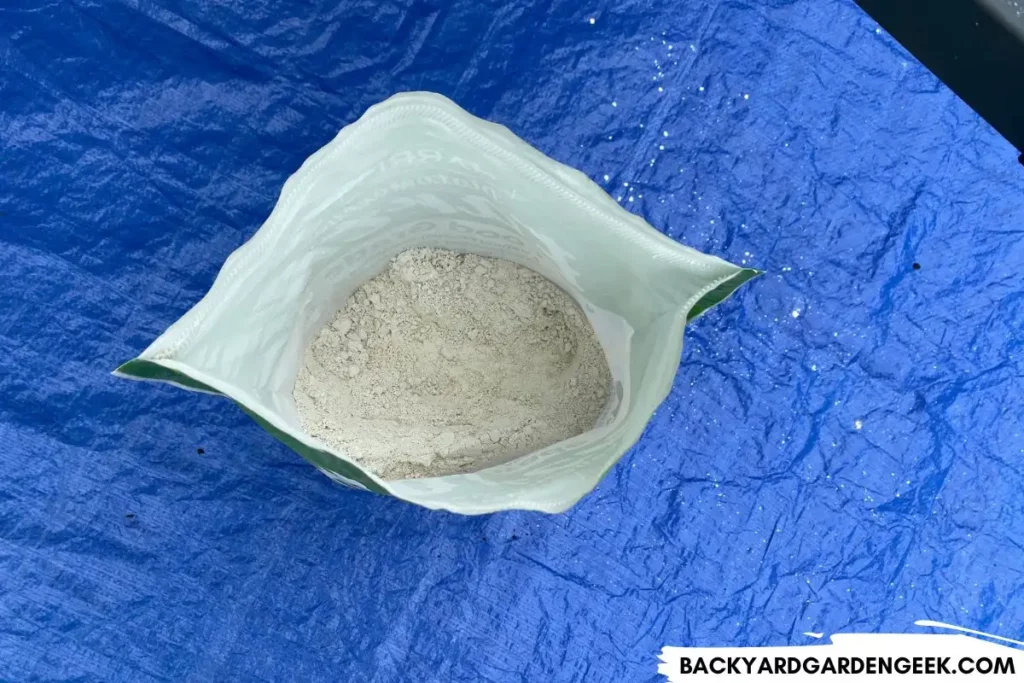
Diatomaceous earth (DE) is a remarkable pest control product made from the fossilized remains of tiny, aquatic organisms known as diatoms.
Deposits of these ancient fossils form a fine, white to off-white powder that feels similar to flour (and just as harmless to the touch).
This seemingly innocuous powder, however, packs a punch when it comes to dealing with unwanted garden pests.
DE’s ability to eradicate bugs originates from its physical properties. If you viewed it under a microscope, you’d notice that DE is composed of a multitude of sharp, jagged edges. These razor-like fragments are lethal to many insects but harmless to humans and pets.
Here’s how it works: Insects, like beetles and caterpillars, are covered by an exoskeleton—a hard, protective outer layer. When an insect comes into contact with DE, the sharp edges of the diatom fossils cut through the protective exoskeleton.
This damage is the first step in a process that leads to the insect’s eventual death.
But the destruction doesn’t stop there. DE is also highly absorbent, soaking up the moisture, oils, and fats within an insect’s body.
After DE has sliced an insect’s exoskeleton, the super-absorbent particles begin to absorb the fluids within the insect, effectively causing it to dehydrate and eventually die.
This quality is particularly effective against soft-bodied insects, like aphids and mites, which lose their vital internal fluids rapidly once exposed to DE.
You might be wondering about the time it takes for DE to kill off insects. The speed at which diatomaceous earth kills pests varies based on the insect’s size, the extent of the infestation, and how thoroughly the DE covers the pests.
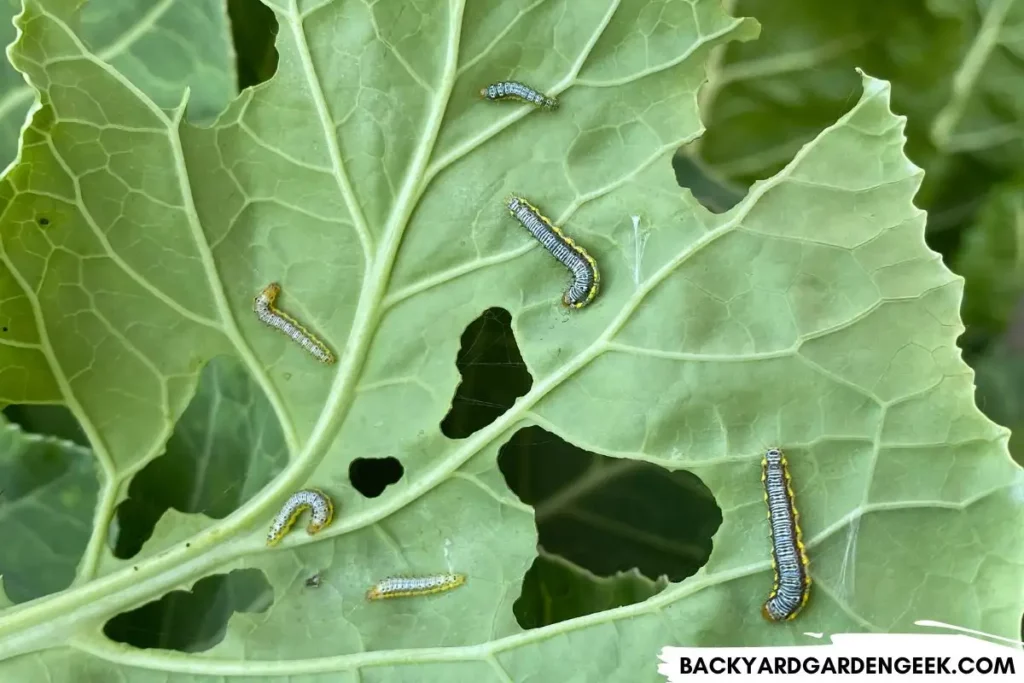
Generally speaking, you could start seeing results within 24 hours of application, but for larger pests or severe infestations, it might take 2-3 days.
Long story short, diatomaceous earth isn’t just a powdery ordinary dust. It’s a highly effective, natural pesticide that kills pests and helps you keep them under control.
Which Bugs Dislike Diatomaceous Earth, and Why Do They Dislike It?
Diatomaceous earth’s effectiveness varies among different types of insects due to their anatomical differences.
Here, I’ll discuss its impact on some common pests, focusing on soft-bodied insects, larger hard-bodied insects, and others like caterpillars, grubs, and mollusks.
Soft-bodied insects—such as aphids, mites, and whiteflies—are among the most vulnerable to DE.
These pests lack the harder exoskeletons found in many larger insects, making them highly susceptible to damage and dehydration.
DE particles can pierce their soft bodies easily, absorbing the vital fluids that they need to survive, leading to rapid death.
Soapy water sprays and neem oil are also effective against these pests as they block the insect’s breathing pores or disrupt their hormonal system, respectively, causing suffocation, abnormal development, and premature death.
However, when it comes to larger, hard-bodied insects like beetles, boxelder bugs, leaf-footed bugs, and stink bugs, DE still stands strong while other methods fall short.
These bugs’ tough exoskeletons protect them from the suffocating effects of soap sprays or neem oil, which fail to penetrate their armor. But DE, with its sharp-edged particles, can breach the hard exoskeleton, causing dehydration and death.
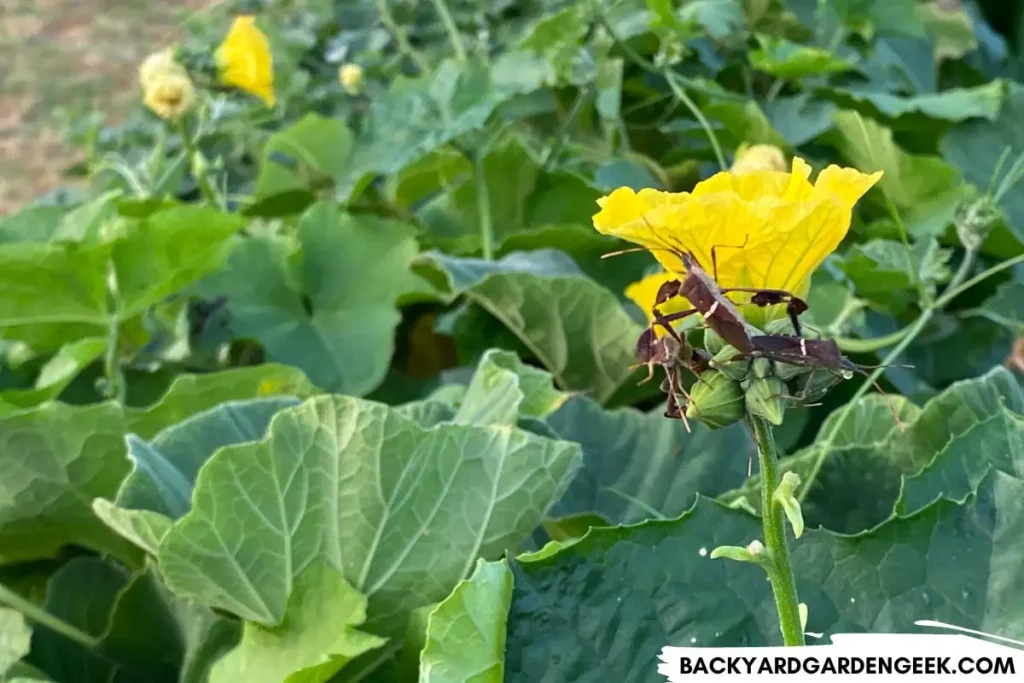
For caterpillars, worms, grubs, and larvae, DE works similarly by cutting into their relatively softer bodies and dehydrating them.
The good news is this: If you kill off these pests before they mature into their adult stages, you’ll offer your garden some preemptive control of potential future infestations.
Slugs and snails pose a slightly different challenge. These are mollusks, not insects, and possess a thick, slimy body coating that offers some protection against DE’s desiccating effects.
DE can hinder their movement, making it uncomfortable for them to cross a barrier of dust and thereby temporarily deterring them from eating your plants. However, DE won’t kill them as it will with insects.
If you understand how diatomaceous earth works, you’ll be able to use DE more effectively on your plants and ward off some of the peskiest of garden pests.
How to Effectively Use Diatomaceous Earth in Your Garden
Now that you know what bugs diatomaceous earth kills and why it kills them off, I’d like to share with you my simple step-by-step method for using it in your garden.
Here are the steps you’ll want to take for an effective and safe application:
- Purchase the right DE: All DE is not created equal. For your garden, make sure you’re purchasing “food-grade” diatomaceous earth. It’s safe for both you and your plants and poses no harmful environmental effects.
- Check the forecast: DE is not effective when wet, so it’s best to apply it on a dry day. Avoid doing so when rain is in the forecast within the next 24 hours.
- Safety first: Even though DE is non-toxic, it’s a fine powder and can irritate your eyes and lungs. Always wear a mask when applying DE and consider using goggles, especially if it’s a windy day. Gloves are a good idea, too, as DE can get all over your hands!
- Spot-check for beneficial bugs: Not all bugs in your garden are harmful. Bees and butterflies, ladybugs and lacewing bugs, parasitic wasps and spiders: These are all beneficial. If these bugs are present, avoid applying DE to those plants for the time being. Thankfully, it looks like DE doesn’t impact earthworms, so you apply it to your soil. Some people even use it as a soil amendment.
- Identify infested areas: Inspect your plants carefully. Look for signs of pest activity like visible pests, chewed leaves, or egg sacs. These are the areas that require your attention.
- Apply DE effectively: A high-quality bulb duster is a handy tool for applying DE. It helps you direct the powder precisely where you want it. Make sure to dust the DE on the undersides of leaves as well, since many pests tend to hide there and lay their eggs.
- Reapply as necessary: One application usually won’t do the trick 100% of the time. Reapply DE once a week, or after any rain, to keep its pest-control effects ongoing. Remember that DE only works when it’s dry.
- Use other pest control methods: While DE is a potent weapon in your pest management strategy, it isn’t the only one. Soapy water sprays can knock down and kill many soft-bodied pests like aphids and spider mites. Neem oil sprays disrupt the life cycle of pests, preventing them from maturing and laying eggs. Use these tools in combination with DE for a holistic approach to pest management.
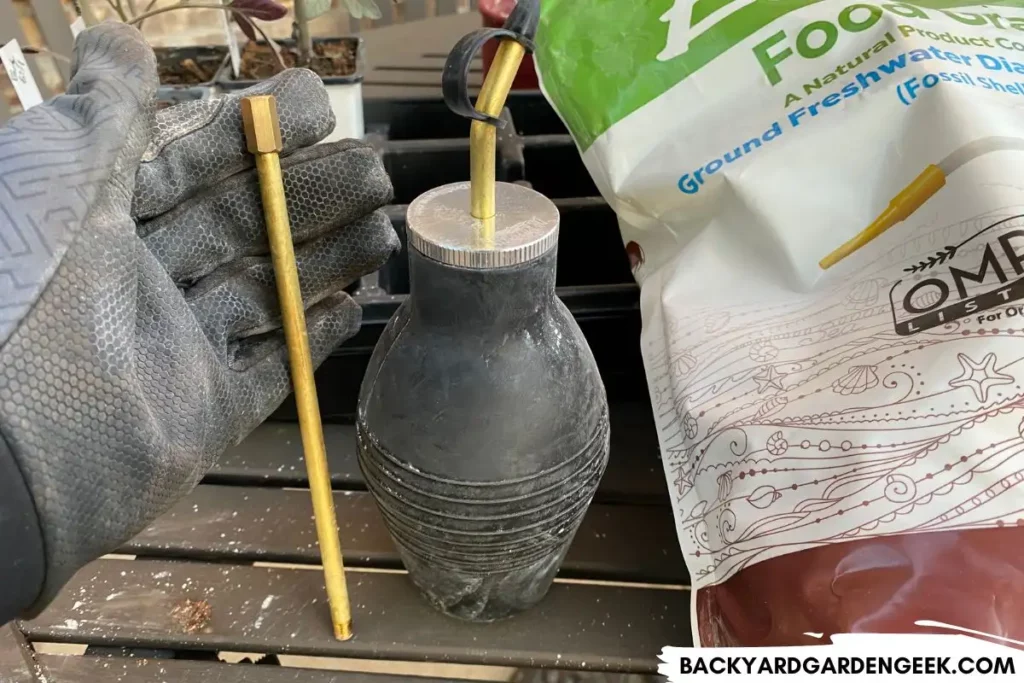
In general, using diatomaceous earth in your garden is more of an art than a science since you’ll need to make careful observations, do strategic applications, and have some patience.
It’s possible to put a little too much DE on your plants, but if that happens, don’t worry. DE won’t harm your plants.
However, when done correctly, DE can help you regain control over your garden, eliminating harmful pests and offering your plants the chance to thrive in a pesticide-free environment.
Additional Information
If you’ve found this article helpful, you might be interested in these related posts:
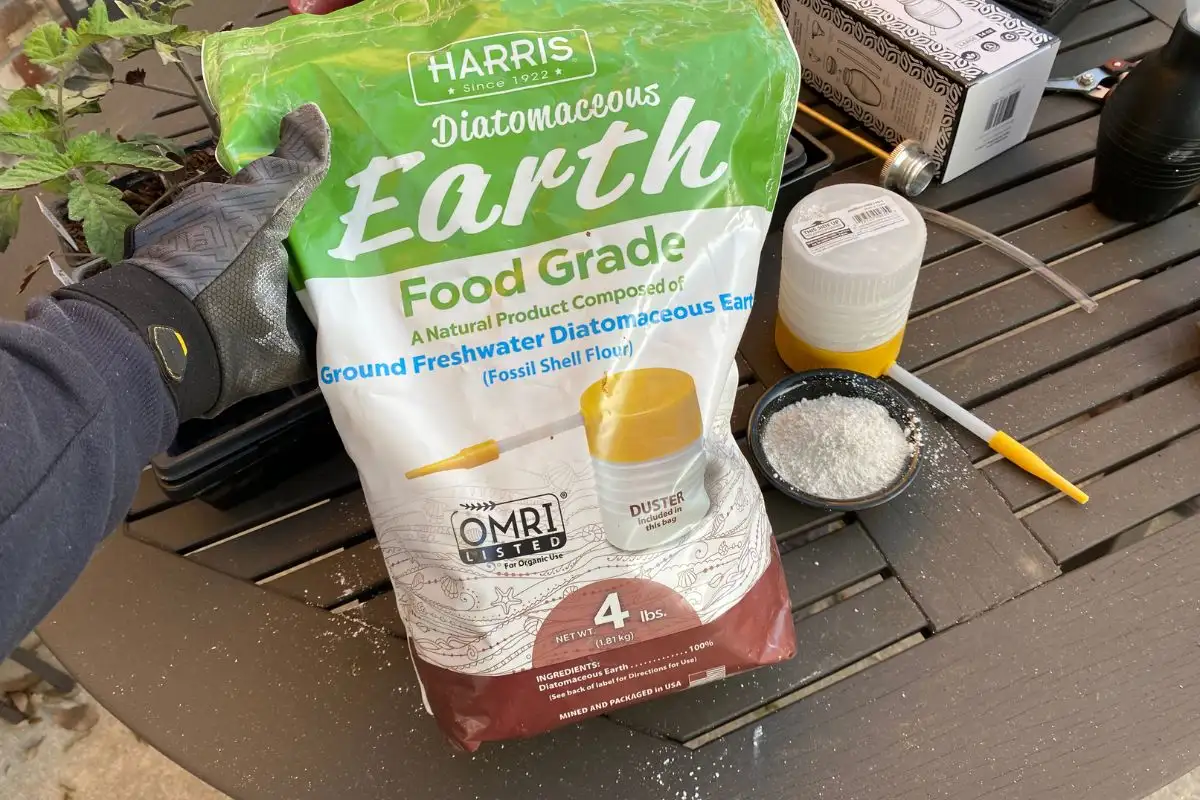
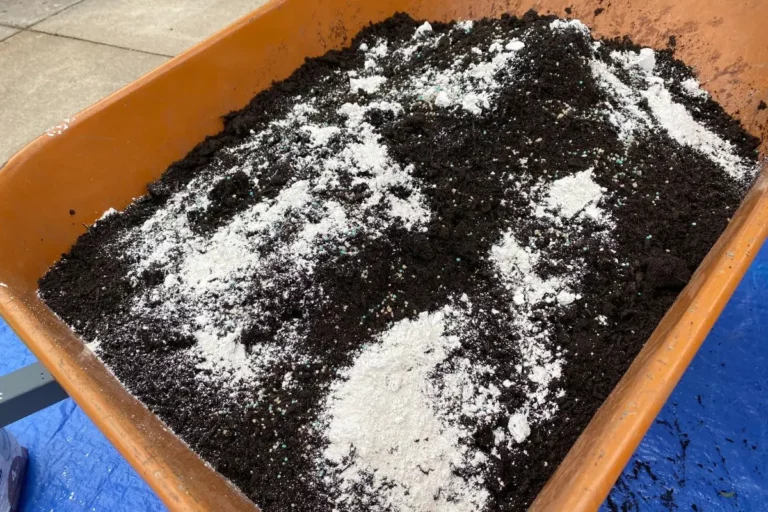


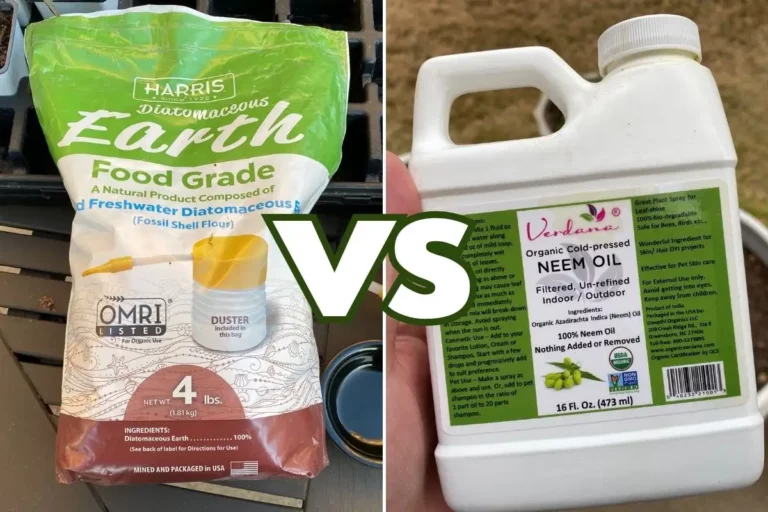
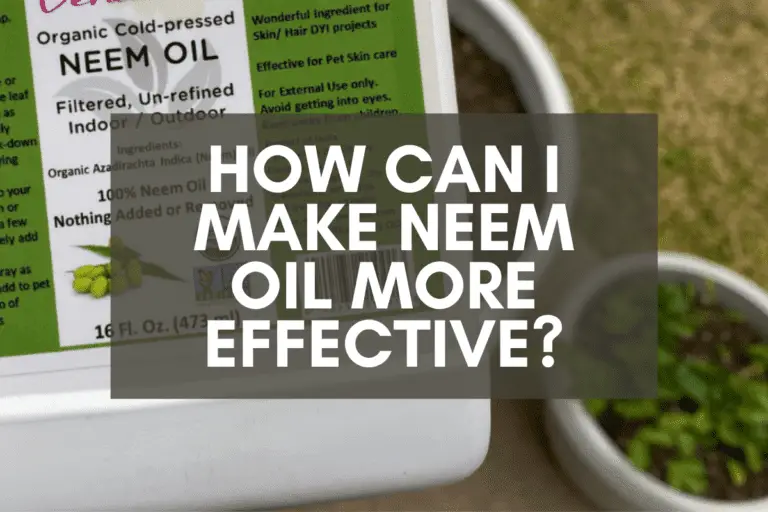

What is the best way to apply for grasshoppers?
Grasshoppers are tough. The only way to hurt them with DE is to spray them directly (or hope they hop directly into the DE). If you can tell you’ve got a huge group in a particular area, you might consider suiting up (overalls, face mask, goggles) and blasting quite a bit of DE in their direction. But I can’t promise this will work since grasshoppers are a pretty resilient pest unfortunately. But if you can blast them from up close, that’ll probably cause a slow death to take place.
If a roach, or other bug, killed by DE, harm a lizard that eats it?
I have native lizards. I like them, hate roaches..
Hi Shelly, I’ve never seen any scientific study on what some refer to as “secondary poisoning” related to one animal eating another that had been covered in DE. My initial thought is: probably not. I’ve been using DE in my garden for years, and my raised beds are teeming with little lizards. I love watching them scurry around, and given their numbers, I can’t imagine my DE has done anything to harm them. In fact, I’ve probably helped them by using DE to keep alive the plants that they love living around!
lawn beetles DE treatment.. how do i use it?
Most beetles are actually good bugs. They dig around, loosen up soil, and then die and decompose. I can’t say for sure what to do unless I know what kind of beetle you’re talking about. But unless you’ve got an infestation of bad beetles (like Japaneses beetles, Colorado Potato beetles, cucumber beetles, or flea beetles), I generally leave all other beetles alone. They’re an important part of your garden ecosystem!
How do I used DE on a 25 ft spruce tree
DE applications on trees, especially larger trees, is going to be pretty tricky. First, you’ll want to identify the cause of your tree problems since DE might not be the best approach, depending on which pest you’re dealing with. Second, I’d recommend calling an arborist to come out and look at your tree since they’re trained for that kind of thing. You’ll sometimes get an initial visit for free, then you’ll pay the arborist for any pest remediation work they do. Without knowing more about your individual situation, I can’t recommend DE for tree infestations.